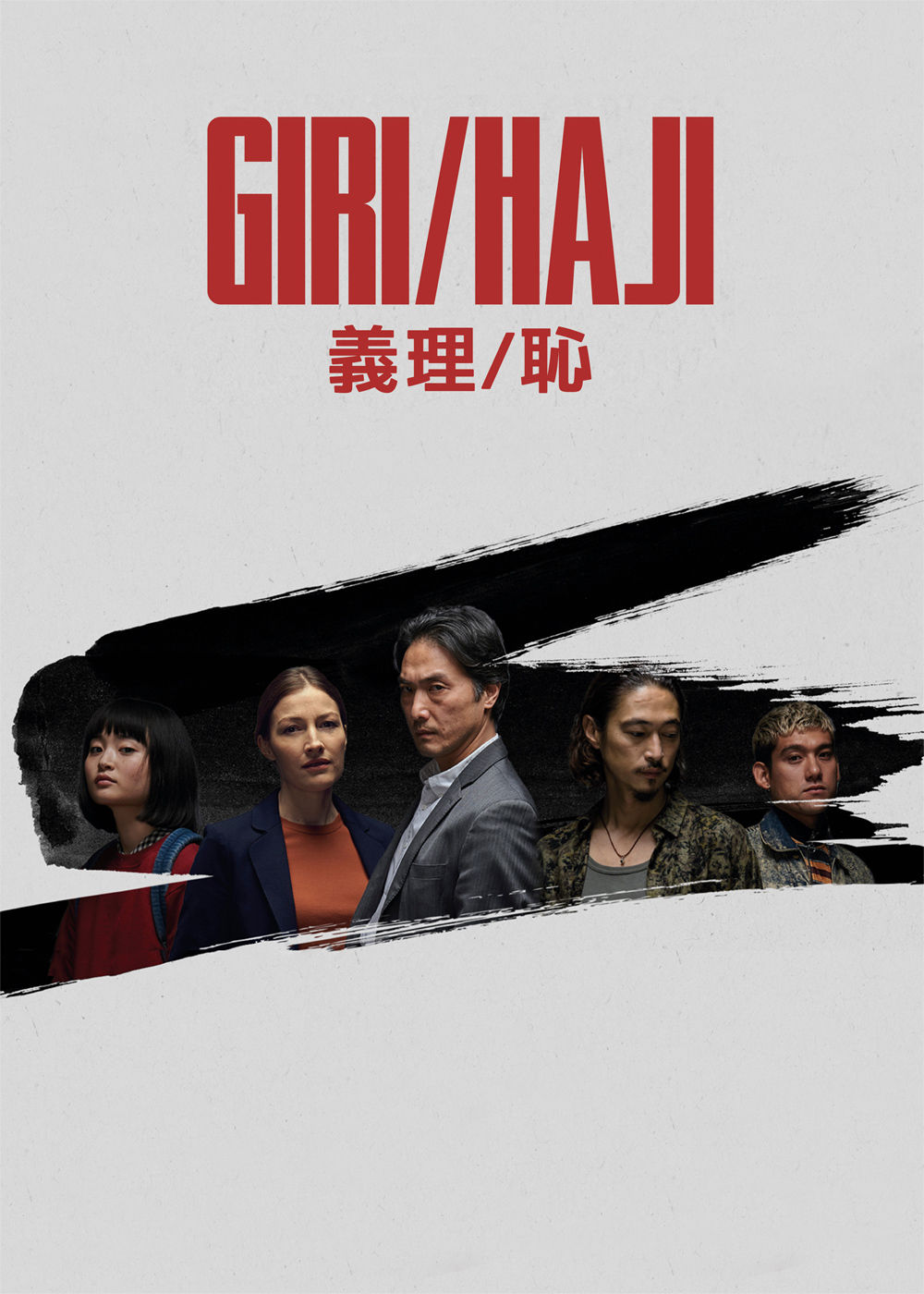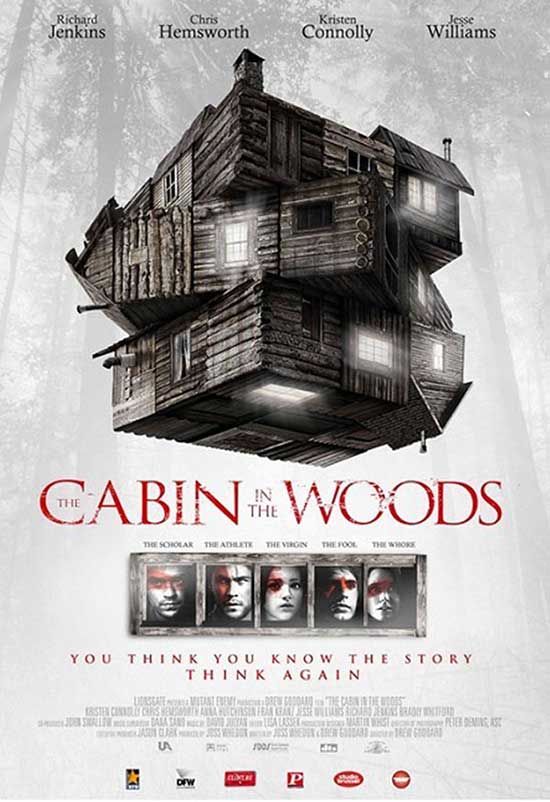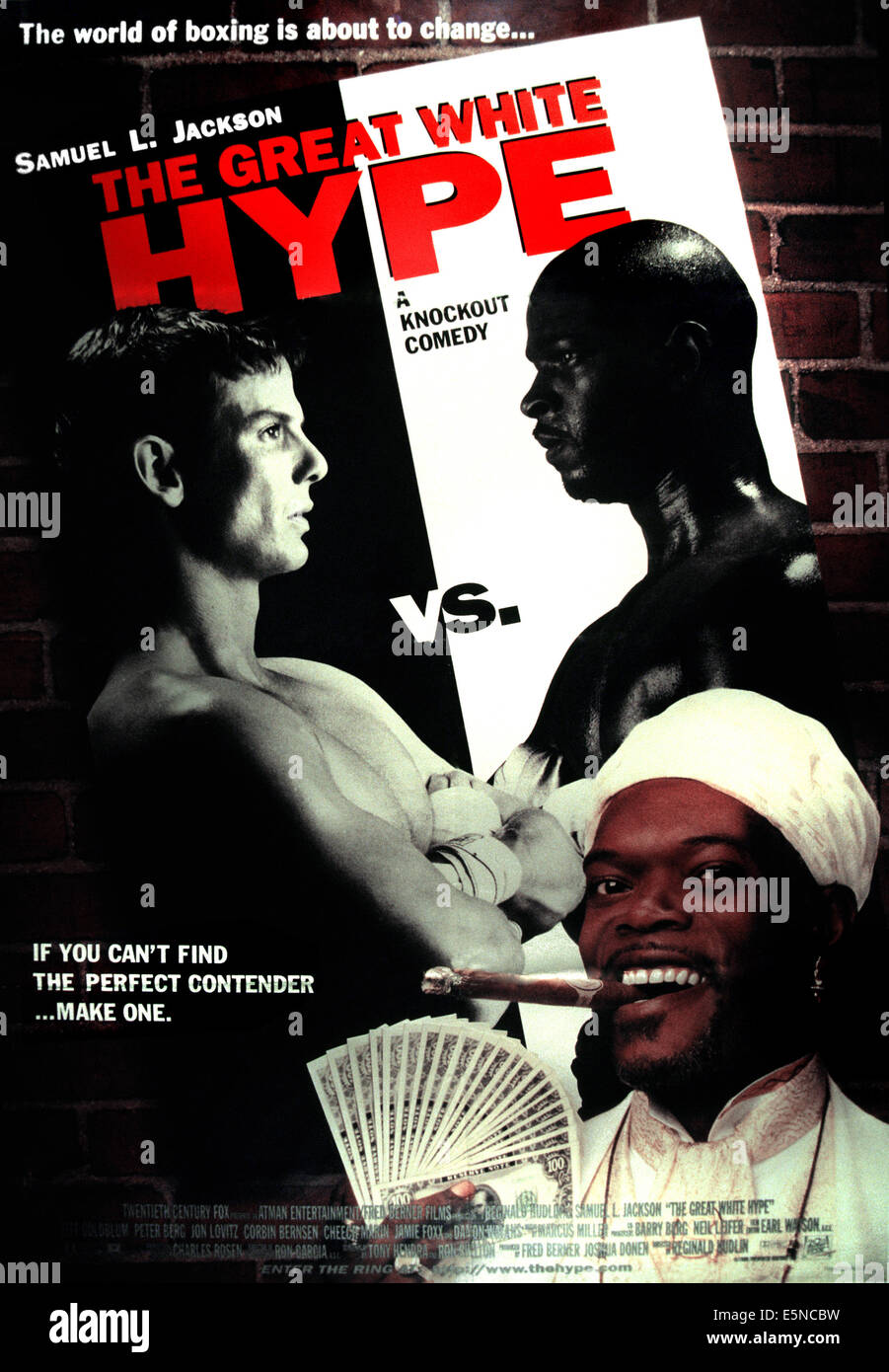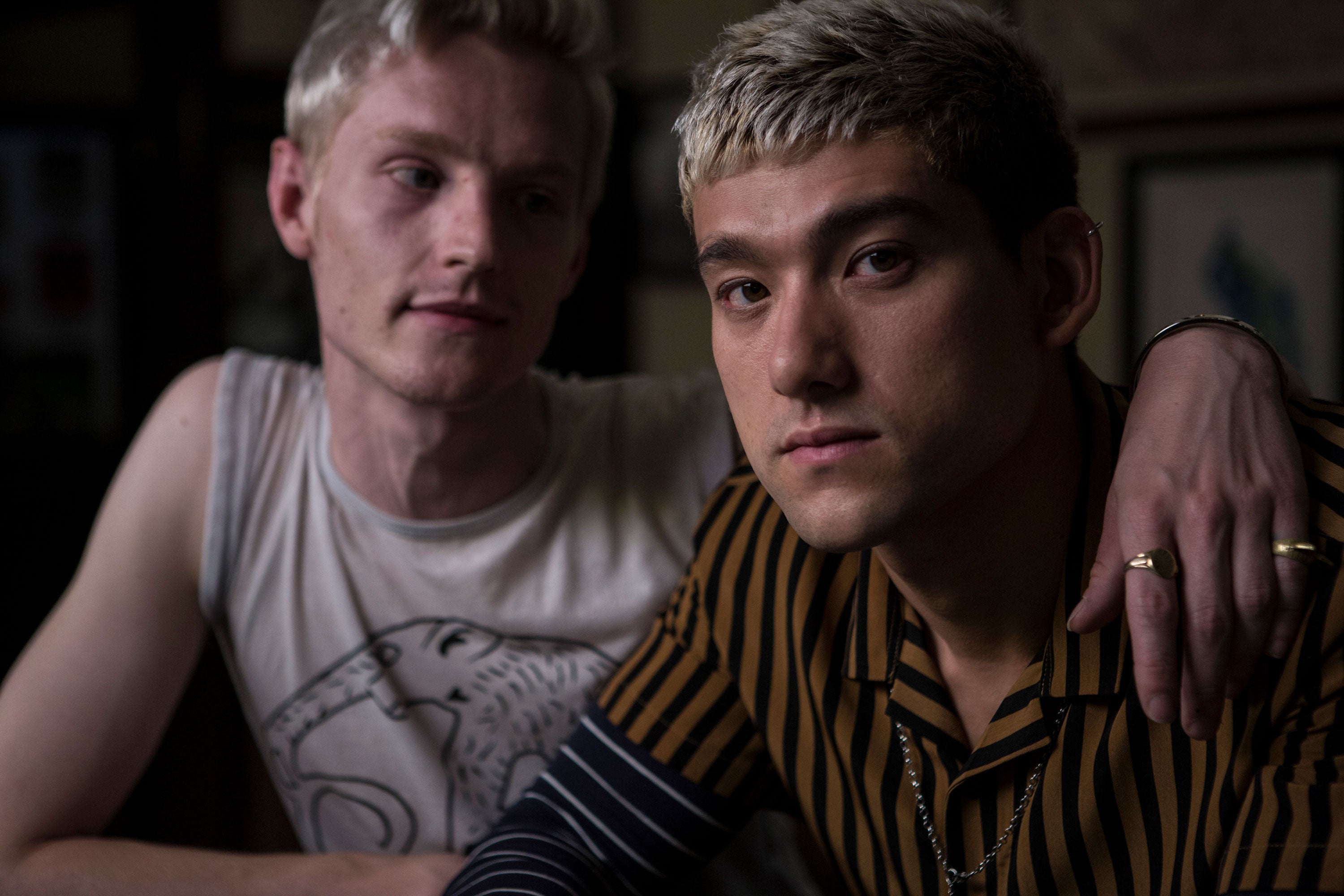 |
| Rodney (front), hanging out in one of his many nighttime haunts. Will Sharpe turns in a great performance as the tough-but-tortured man. |
Tuesday, August 25, 2020
Idiot Boxing: Giri/Haji (2019)
Monday, August 24, 2020
The Raid: Redemption (2011)
Director: Gareth Evans
A martial arts/action movie tour-de-force that I finally got around to watching. I can see why it quickly became such a beloved classic among fans of the genre.
The story isn't terribly complex: in a beaten-down, urban neighborhood in Indonesia, a S.W.A.T. team launches an assault on a building held by a violent, ruthless drug kingpin. The team has to battle its way to the drug lord on the top floor of the blasted concrete structure, fighting through wave after wave of thugs and henchmen armed with guns, knives, and some ferocious martial arts skills. One of the S.W.A.T. members, Rama, is especially adept at both fighting and seeing the larger picture at work, and he becomes one of the very few members of his team to get beyond the first few floors of the death trap building.
The Raid: Redemption goes all out as an action/fighting movie. Although I only just saw it for the first time, I remember hearing about it from a few action-loving friends back around 2012, when it really wasn't shown much in the U.S. Now I can see what they meant. After only about five-minutes of barely-necessary but simply effective "plot" setup, things go totally nuts for Rama and his team. They're getting sniped from nearby buildings, blasted from floors above them, and generally attacked from every angle imaginable. They acquit themselves fairly well and fight back admirably, but the tension and carnage are never more than one minute or one corner away.
So it's one thing to just pack a movie with action. More importantly is whether the action is visually engaging. The answer for The Raid: Redemption is a definite "Yes!" However, this answer will of course be dependent on how one feels about action scenes. Some people can't get enough well-done fighting and action scenes in movies. Other people - like my wife - immediately tune out the moment a car chase, fistfight, or gunbattle erupt in a movie. I find myself somewhere in the middle on this - I'll remain engaged for a while in an action sequence, as long as it shows some visual and choreographic creativity. But my engagement will usually wear down after a while, if the action overwhelms the emotional or narrative elements of the movie. With The Raid, I did eventually grow less interested in the on-screen mayhem, despite recognizing how extremely well-done all of the action elements were executed. But if you dig intense, well-shot fighting in many forms, then you'll love the action in this movie. There's no "shaky cam" work, and the brutality of the confrontations is palpable at all times.
 |
| This one key fight scene conveys just some of the intensity of the combat and the rather stark backdrops for much of the action. Still, everything is lit and shot impressively. |
Will I watch this again? Most likely not. I'm not a pure enough action fan to feel the need. However, I'll probably check out the sequel, The Raid 2, as it is also considered a very influential modern action movie. I'll be curious to see what writer/director Gareth Evans was able to do with a bigger budget, though I won't expect there to be much more beyond a similar fireworks show of punching, fighting, and shooting.
Friday, August 21, 2020
In A World...(2013)
This was a rewatch, and it was well worth it. Liked this movie when I saw it in the theater back in 2013, and I still like it.
The movie follows Carol Solomon (Lake Bell), a voice coach and voice actor in Hollywood who is trying to break into a larger role. The daughter of a highly successful movie trailer narrator, Carol faces an uphill battle in the male-dominated, chauvinistic world of movie-trailer voice-overs. A little stroke of luck opens a small door for Carol, which she then parlays into ever-better voice-over gigs, eventually landing a chance to voice the trailer for a massive, blockbuster upcoming movie franchise. However, there is some very stiff competition for the job, including her self-important, chauvinist father. Carol tries to keep her eye on this occupational prize, all while juggling several rough hiccups in her personal and family lives.
In a World... is a really fun look into a part of the movie business that many of us don't ever see and probably never think much about. And it's a world that writer, director, and star Lake Bell, a highly accomplished voice-over artist, knows plenty about. Despite seeming to be a minor, almost inconsequential part of a visual medium, she offers us a look at a cut-throat world filled with massively outsized egos and comically competitive scrambling. Once the dash for the coveted movie voice-over job is on, it's hard not to be invested in Carol's prospects of winning the gig. Unlike many of the "behind the scenes, movies about movies" shows that we've seen over the years, the stakes here are smaller on one level, but they also carry plenty of weight for the authentic characters we get here. In addition to Lake Bell, her father is played by longtime voice-over master Fred Melamed, who brings a ton of comic acting chops to the movie. These two and others help make a "small" world carry some actual weight for the people who dwell in it.
 |
| The voice- and sound-obsessed Carol (left) surreptitiously records her unwitting sister. Plenty of humor in the movie comes from Carol trying to get various recordings for her work. |
I highly recommend this one to anybody who enjoys movies about movies or smart comedies about people trying to break through barriers to flex their talent.
Saturday, August 15, 2020
John Wick 3: Parabellum (2019)
Not sure why I didn't review this one when I first saw it in theaters last year, but oh well. This third "chapter" in the John Wick series continues to do what the previous two did - provide slick, exceptionally well-executed, intense action within a visually stunning setting dark mythology. Like it's predecessor, Chapter 2, this one was arguably a bit longer than necessary, but was overall good.
The previous movie ended with John Wick, assassin extraordinaire, being declared "Excommunicado" by the vast and rules-dominated system of criminals and professional killers, meaning that he is now hunted by hundreds of his fellow killers-for-hire. He is also without the benefit of any legitimate form of sanctuary - something which provided him a great advantage in the past. So alone and seeking a way out of this lethal dilemma, John calls in a couple of very old and very valuable favors, ultimately being granted a meeting with a mysterious, powerful figure (billed only as "The Elder") who seems to hold sway over the immensely powerful criminal organizations that all want John dead. In exchange for safety from the countless killers after him, John agrees to serve him for the rest of his life in addition to killing Winston, longtime friend of Johns' and the manager of the New York Continental Hotel. Almost needless to say, things don't exactly work out the way that The Elder and the other most powerful criminals lords hope, with John and a few friends killing dozens upon dozens of would-be assassins along the way.
I have to tip my cap to this franchise - it's done a brilliant job of taking a simple, crowd-pleasing idea and executing it with a satisfying amount of style, novelty, and exceptional attention to detail. The first John Wick made its mark in two ways: by bringing an intense, "extended shots" approach to filming action and fight scenes, and setting the story within a novel, dark fantasy world with its own mythology and rules. Chapter 2 got deeper into that mythology, and it managed to show that they could offer equally intense fights with novel twists, either through the settings or the methods that the fighters used. Parabellum continues this trend, giving us new, often exotic and dazzling locations and sets, and adding fun wrinkles to the combat. And there's a lot of combat. I know this will be sacrilege to the millions of Wick faithful, but I actually thought there was too much combat. I'll explain later.
The combat and action scenes. Look, they're great. This is by far the major draw to this entire series, and Parabellum keeps the bar exceptionally high, arguably raising it even higher than the previous film. Whether it's on-road pursuits, hand-to-hand fighting, or gunplay, this series continues to dazzle. We've already seen how well the action and fight sequences are choreographed and shot, so that's no surprise. What each new film offers, though, is new environments, weapons, and other props. Yes, it's John Wick killing people by the bundle, but nearly every new fight does something new and different in its dark, brutal way. Just a few examples from Parabellum include a motorcycle pursuit of John on a horse, one of the longest knife-fights you'll ever see, Halle Berry using a pair of bulletproofed attack dogs, and more. Honestly, my Dad and I (we went to see it together in the theater) were as entertained by the over-the-top novelty of the kills as much as anything.
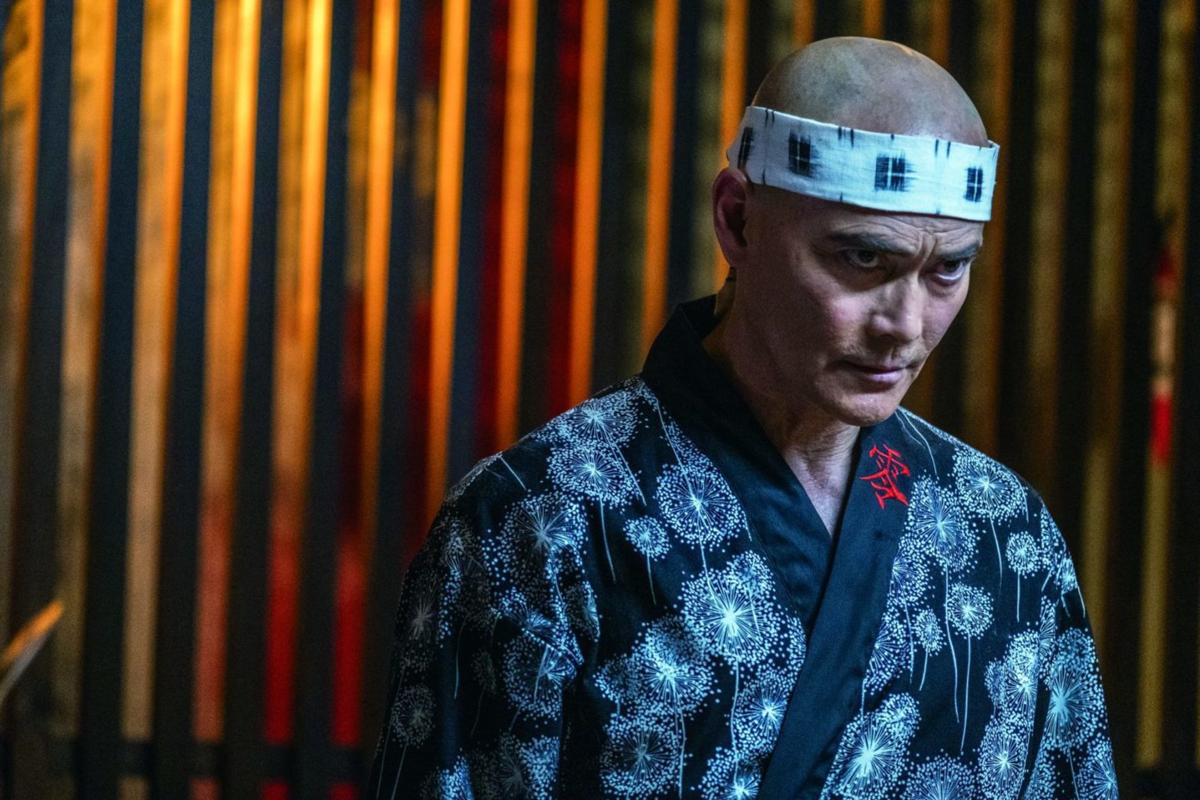 |
| This is Zero, John's primary fighting adversary in Parabellum. He's actually been my favorite so far, adding some levity to the intense fights. |
There's a very interesting possible path that this series may go down - the path of "tearing down the entire system." At this point in the overall story, I'm hoping that we now have the basic framework of the vast, rule-governed network that all of these criminals and killer operate within. John's arc so far suggests that he is ready to break free of it entirely, and he is now in the position where the only way to do so is to destroy it completely. This would be the logical - and extremely fun - path for the future movies to take. I recently heard that the plan is to film both the fourth and fifth movies together, so we can expect at least two more chapters in this "franchise." I'll definitely check them out, even if I'll go in expecting to grow a bit tired of the bloodletting if they go much beyond the hour-and-a-half threshold.
Friday, August 14, 2020
The Devil Wears Prada (2006)
Finally sat down with the wife to watch this oft-referred-to film. Not bad, and I can see why it generates a lot of discussion and debate, even nearly 15 years after its release.
The movie follows Andy Sachs (Anne Hathaway), an aspiring young journalist struggling to land work as a writer in New York City. Looking for any way to get her foot in some kind of door, Andy applies to become an assistant to Miranda Priestly (Meryl Streep), the brutally exacting and vicious editor-in-chief of an immensely popular and prestigious fashion magazine. Despite knowing and caring very little about fashion, Andy lands the job, agreeing to be Miranda's assistant for a year, in the hopes of getting a bulletproof recommendation for a job in journalism. After many rough growing pains and adjustment, Andy embraces the world of high fashion, along with the incessant and often boundless demands of her boss, eventually alienating her closest friends. By the end of the tale, Andy has learned Miranda's one great lesson to her: reaching the top of the world of fashion requires a ruthlessness and focus that Andy simply does not have. Still, Miranda helps her land a good job at a New York City newspaper, thus kickstarting her career as a journalist.
It's not hard to see why this movie is basically like mainlining heroin for anyone remotely concerned with fashion. You have a ton of great actors and beautiful people putting on great performances, nearly all dressed in flawlessly chic outfits, turning in great performances. Even more, these dynamic characters are all about the world of looking striking and powerful through your clothing. In short, if you dig really nice clothes, you'll dig looking at this movie. Of course, the film goes beyond this, digging into the essence of fashion (to an extent) and its greater place in society. This is what makes Andy's character essential. Like many of us, she's a fashion neophyte, so her entry into the world is our entry to the world, and it's handled well enough that even someone like me can find it interesting.
The greater reason that this movie was and still is so often discussed is the Miranda Priestly character and, to a lesser extent, her relationship with Andy. I see three aspects to Miranda that inspire debate: representing a successful woman in a cutthroat business, her management style, and her estimation of fashion's place in the world. Based on the Lauren Weisberger novel of the same name, The Devil Wears Prada is based on the author's time as an assistant to Vogue magazine editor Anna Wintour, so Weisberger had a first-hand look at a woman who makes it to the top of this very industry. The movie certainly suggests that a woman must be at least as ruthless as a man to reach such heights, even though it doesn't completely dig into this theme.
The more obvious (and entertaining for many people) element to the movie is how Miranda is a Hall of Fame-level "horrible boss," in that she's brutally demanding of Andy and everyone else around her. Because of her success in the fashion world, all of her employees are constantly on pins and needles, continuously attuned to her every word, movement, and gesture. With very few exceptions (such as Stanley Tucci's character), this all creates a palpable "terrified of Mom" vibe around the entire magazine. Many viewers find this comedic, but I almost always grow irritated when seeing or reading about such characters. My feeling is that anything that forces a person to become such an obsessive, exacting tyrant is unhealthy, and I have a hard time watching it happen, even in fiction.
 |
| Apparently, countless fans have weighed in on whether Andy's friends are good or horrible. Arguments can be made for both sides, but this actually speaks to a slight lack of depth in the film. |
I did enjoy that Andy ultimately turns her back on the fashion world. It does go some way towards suggesting that one's humanity is more important than pure success, especially conspicuous success. True to its nature, fashion is all about being seen a certain way, regardless of how true it is to the actual person putting it on display. This seems to be the moral of the story, if there is one, and I can get on board with that.
I'm glad that I finally got around to seeing this one, as it's so often referred to and is one that my wife has seen multiple times and enjoyed. I found it to be a well-made movie that raises some interesting themes. And while it doesn't dig into some of the more difficult questions as much as I might like, I appreciated the messy, grey areas that it included. Good movie, though not one that I'll feel the need to see again any time soon.
Wednesday, August 12, 2020
The Cabin in the Woods (2011)
I actually own this movie and gave it a rewatch - my fourth viewing of it since it came out. It's still a ton of fun, honoring so many great horror standards with its clever "meta" approach.
The movie follows five college friends as they take a weekend trip to the secluded, titular cabin in the woods. As they approach, things start to take turns very familiar to anyone who has seen popular and cult horror movies from the 1980s and later: the cabin is a dark and foreboding; there's an eerie basement with a vast assortment of creepy objects; and the overly curious visitors accidentally unleash hellish forces that seek to kill them all. Before the proceedings turn wildly violent, we also get some overt sexuality and dashes of budding romance. Again, very familiar tropes of the horror genre. What is new here is that, outside and above everything happening in and around the cabin, is a vast, bureaucratic organization that is orchestrating the entire thing. Their purpose is to stage the entire group execution, all unknown to the five victims, in order to appease a group of Lovecraftian "old gods" who slumber beneath the earth. These titans of evil and destruction only refrain from annihilating humankind if an annual ritual sacrifice is made in order to appease them.
The Cabin in the Woods is so entertaining, especially for horror fans. I'm not a hardcore horror aficionado by any means, but I've seen most of the standards and classics. I've also enjoyed many of the most frightening and clever films in the genre, like The Shining, the Evil Dead trilogy, and An American Werewolf in London, among many others, multiple times. Like many of the greats, The Cabin in the Woods, written by Joss Whedon, finds a perfect balance between giving you legitimate scares, making you laugh, and dazzling you with its mysterious and layered tale. Yes, the main five characters are loose archetypes of the typical slasher victims: the jock, the whore, the nerd, etc., but Whedon added more depth to them and made them genuinely funny and empathetic. They crack good jokes, and when things start to go horrifyingly haywire, we actually care.
 |
| Our five friends begin to sense something horribly amiss in their weekend getaway cabin. Things only get crazier, on many literal and figurative levels. |
The third act of this one is what really puts it over the top, though. Once the grand secret is revealed and the two "survivors" uncover the greater scheme at work, this movie supplies so many fun "Oh shit!" moments in the form of revelations, more creepy horror entities, and straight-up action. To cap it all off, it has the guts to supply a rather dark ending, something which I always appreciate, especially in horror movies.
Back when I first bought a blu-ray player, The Cabin in the Woods was one of two blu-ray discs that I purchased to break it in. I'm glad I did, as I've gone back to it every few years since, and I'll continue to do so.
Tuesday, August 11, 2020
The Great White Hype (1996)
Still a vastly underrated satire of the last gasps of boxing as a premier sport in the US.
Released in 1996 and obviously drawing heavily on the realities of the boxing world at the time, The Great White Hype tells the tale of the attempt to find a challenger to the current undefeated heavyweight champion, James "The Grim Reaper" Roper (Damon Wayans). But the problem is not that legitimate challengers don't exist - it's that the sport is rapidly fading in popularity, resulting in ever-decreasing profits for those who seek to profit from the once-wildly-lucrative industry. Seeking to crack this nut is Reverend Fred Sultan (Samuel L. Jackson), a Don King-like figure who is a shifty, manipulative promoter not above anything it takes to make a huge payday for himself. The grand solution, as he sees it, is to find a modern rarity - a white boxer who can square off against Roper and encourage greater interest through subtle and not-so-subtle race-baiting of the viewing public. The obvious problem, though, is that there isn't a decent white heavyweight fighter anywhere on the scene. The Sultan's solution? Concoct one. The Sultan and his team of sleazy underlings find heavy metal rocker Terry Conklin (Peter Berg), who had once beat the champion Roper when the two were amateurs. The rather dim Conklin hasn't fought in about a decade, but the Sultan convinces him to return to the ring, all the while whipping up a huge marketing campaign around the first black-versus-white heavyweight title bout in ages.
I hadn't seen this movie since my college days back in the mid- and late-1990s, when I watched it several times and would regularly quote it with my friends. While I would never argue that it's a "great" movie, I'm still somewhat baffled that it's not given more respect as a funny, clever sports satire. I was actually completely unaware of its theatrical release, despite its having several well-known actors like Samuel L. Jackson, Jeff Goldblum, and plenty of others. A little research shows that it wasn't very well received by critics at the time, and still sports very mediocre reviews on any major film ratings site. My only guess is that the R-rating and slightly loose feel to the film may have turned off some viewers. Also, being a satire of a notoriously seedy sports industry, the movie derives a lot of its humor and message from the darker aspects of human nature. There is also a chance that, like me the first time I watched it, viewers didn't know what to make of the ending. For my part, I hadn't picked up on just how satirical the entire story was meant to be, until a friend explained it to me. Once I understood that, the movie actually went considerably up in my estimation.
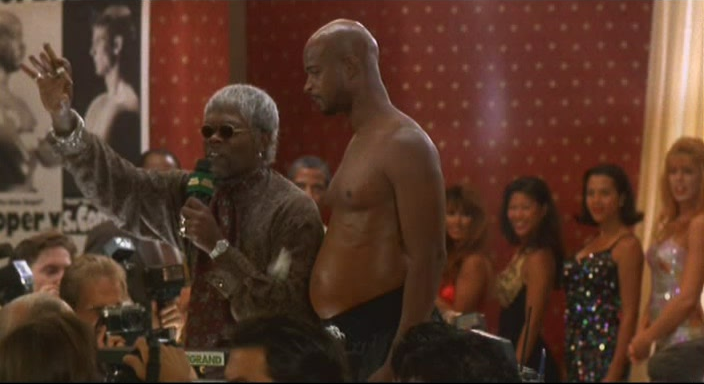 |
| The Sultan hyping up the fight in front of the champ, "The Grim Reaper" Roper. Roper's disdain for his opponent manifests itself as an utter refusal to even train for the fight. |
